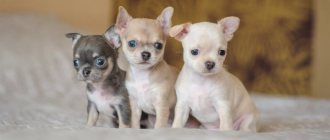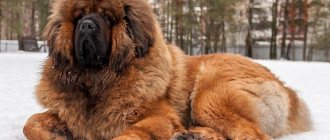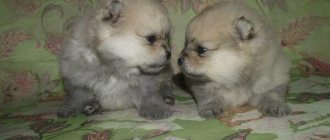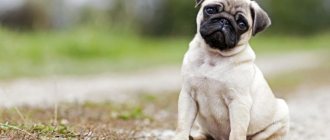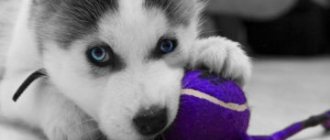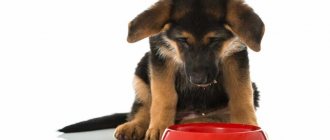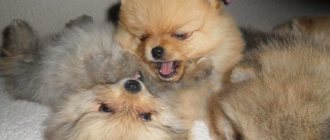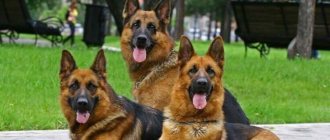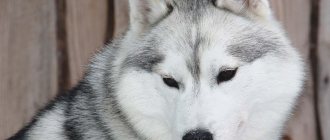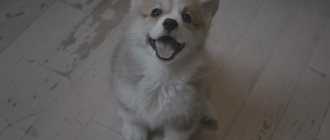History: why it was bred
The history of the breed dates back to ancient times - the first mention of the Tibetan mastiff is found in the Chinese book of changes Shu-king of 1122 BC. In addition, Aristotle himself wrote about these dogs! Marco Polo praised this breed in his notes on his travels to Asia. Of course, over such a huge period of time, the truth has long been mixed with myths and legends, but one thing is known for certain: the breed comes from a wolf, which is typical for all mountain dogs of the Molosser group.
This dog breed first appeared in Tibet. Even in the works of Herodotus, “Indian” dogs are mentioned. They are the progenitors from which the Tibetan Mastiff comes. Its origin as a separate breed is considered to date back to the 7th century BC. These dogs were guard dogs in Tibetan monasteries and assistants to nomads in the Himalayas.
There are very interesting and fascinating legends about Tibetan mastiffs: in Tibet they believe that the light spots of the dog’s “eyebrows” are another pair of eyes with which the dog looks straight into the soul and determines whether the person in front of him is good or bad. Peasants also believed that the Tibetan mastiff never sleeps: when one pair of eyes is closed, the other is awake.
The first Tibetan mastiff came to Europe in 1847, it was brought by Lord Harding to Queen Victoria of England. These dogs began to be bred in Germany in 1979. Here's what today's representative of the breed and the dog of the past look like in the photo:
Then
Now
History of the origin of the Tibetan Mastiff
No researcher can say exactly where, when and how Tibetan mastiffs appeared. Dogs of this breed, judging by the many genetic analyzes carried out, are one of the direct descendants of wild wolves domesticated by ancient man. Archaeologists managed to find the remains of dogs similar to Tibetans that accompanied people living in caves. Mentions of man’s formidable four-legged friends are found in the works of Aristotle and Marco Polo.
One way or another, it is believed that the homeland of the Tibetan mastiff is Tibet. It was in this remote corner of the world that menacing-looking animals guarded the temples at night and were faithful friends and companions of the monks. The dog's ferocity, menacing gaze, powerful physique repelled all kinds of onlookers from the spiritual monastery. In addition, mastiffs protected the inhabitants of mountain villages from the invasion of strangers.
The breed was a kind of endemic for a long time, which allowed it to retain all its characteristic features. The Tsang-Khi first left Tibet, going to the Chinese Emperor as a “trophy”. It’s easy to guess that dogs soon became an indispensable element of wealth. In addition, Tibetans were presented to representatives of many Asian countries, which gave impetus to the development of other similar breeds.
The nineteenth century was marked by the arrival of Tibetan mastiffs to Europe, more precisely to Great Britain: first, the King of India gave Queen Elizabeth a Tsang Khi puppy, then Edward VII brought several puppies to the United Kingdom. Aristocrats became interested in these unusual animals after an exhibition at the Alexander Palace (cultural and entertainment center), and Tibetan mastiffs became full-fledged residents of Foggy Albion, from where they spread throughout Europe. The time it took to win the hearts of Europeans was about fifty years.
1931 was marked by the creation of a breed standard (Frederick Bailey's wife had a hand in this) and its inclusion in the register by the Association of Tibetan Dog Breeds. The Kennel Club took it as the basis for forming its own list of traits inherent in Tibetan Mastiffs.
The period of the Second World War was equally difficult for all representatives of rare breeds, including Tibetans. Breeders of the period 1939-1945 made every possible effort to preserve the gene pool of Tibetan mastiffs, because due to the occupation of some countries, the supply of new individuals to the mainland stopped. Having restored the Tsang-Khi population, the breeders decided to give a gift to the American President - a faithful friend who did not make the right impression on the politician and was sent to the ranch.
Twenty years later, the position of the breed in the United States improved due to the importation of new purebred individuals from Tibet. In 1969, the Americans achieved the opening of the Association of the American Line of Tibetan Mastiffs. Ten years later, American individuals took part in the exhibition and received their share of attention from breeders from other countries.
Today the breed remains at the peak of popularity in China (where they are willing to pay a lot of money for its representatives), but in other countries only a few are involved in keeping four-legged giants. Purebred individuals are a rare occurrence in large countries such as Great Britain and America, but in smaller countries things are not the best. In our country there is no talk of opening a nursery due to the small number of animals of this breed located on its territory.
Species and types
Experts have identified 3 types of Tibetan mastiffs:
- Tsang-Khi , also called valley type. This is a purebred, the rarest and most valuable type. They are the largest and most massive compared to other types. Males – 75 cm at the withers and above, females – 70 cm. Main color – black and black and tan. They were raised in monasteries for protection. This breed is not suitable for running. A characteristic feature of this type is an unusual bark - velvety and low. Breeders try to preserve this trait in the breed.
- Dro-hi , also called mountain herding dogs. This is a widespread European type of breeding. They are slightly smaller in size and not as massive as the Tsang-Khi. Males - 73 cm and above, and females - from 63 cm. The head is large relative to the body. Characteristic colors: golden, black and tan and black.
- Lion type. They are smaller in size compared to the two previous types (from 70 and 65 cm, respectively, males and females). They got this name because of the hair on their head, reminiscent of a lion's mane. They have an elongated body and a shorter muzzle. The most common colors are black, black and tan, gray, and gray and tan.
- Tiger type. It differs from the lion in that, although it has a mane, it is smaller.
- Chinese type. The most controversial line of the breed. Many dog handlers treat dogs from China with extreme distrust and do not call them anything other than a “Tibetan” mastiff. They say that the breed bred by Chinese breeders shows too much pure commercial interest - so the situation in the breed is strange. It should be taken into account that the Chinese Mastiff is not a purebred Tibetan Mastiff. Chinese lines also include other breeds, which are often visible even in photographs.
Dimensions and weight
On average, healthy TM puppies at the time of birth have a valley of 20-27 cm and weigh 400-600g.
| Puppy age in weeks | Ongoing processes |
| 1 | The puppy's primary adaptation to the conditions of the surrounding world occurs: temperature and smells. During this period, the baby’s body is dense, elastic, covered with smooth hair. |
| 2 | The beginning of the transition period. The babies continue to grow actively, and by the end of the second week their weight increases 3 times. Towards the end of the second week, the puppies' eyes and ear canals open, and the baby begins to see and hear. The first baby teeth also appear. |
| 3 | At this stage, the puppies are little by little trying to get to their feet and take their first steps. By this age, thermoregulation improves, and the puppies begin to be less jealous of their mother. At the same age, they are allowed to try solid food. |
| 4 | The babies become more inquisitive and active, crawl out of the nest and begin to play with each other. At this stage, the personality of the future dog begins to form. |
Description and breed standard with photo
Colors
Colors that representatives of this breed may have:
- black,
- brown,
- red,
- golden,
- chestnut,
- black and tan,
- grey,
- grey-tan.,
- blue.
The standard allows for white spots on the chest or paws.
The most common and classic color (the calling card of the breed) is a combination of black and tan: black fur on the head and back with light yellow or brown paws, sometimes there is a light spot on the chest. The Chinese believe this is proof of a brave heart. It is dogs of this color that have pronounced tans - “second eyes”: symmetrical light markings on the eyebrows.
Next in popularity: the so-called red shade, or more precisely, copper, red, from light fawn to copper-burgundy shade.
Blue and blue and tan are very beautiful, although rare colors.
Photo of blue color
Gray-blue
Brown Tibetan Mastiff
Is there such a thing as white?
Pure white dogs are extremely rare. But due to the difficulties of breeding them, white color is not accepted as a standard. The white mastiff is the most expensive of the rare breeds, and can cost up to a million dollars.
Standard
- The tail is medium in length, set high on the line of the back, carried high, curled to one side, with developed decorative hair.
- The head is massive, wide, with a large skull, the back of the head is clearly defined, as is the transition to the muzzle from the forehead.
- The muzzle is wide and has a blunt edge when viewed from any angle. Wide nose with pronounced pigment, open nostrils,
- bite , a straight bite is also allowed, massive jaws, teeth close tightly together.
- The eyes are medium in size, oval in shape, set wide apart, brown in color, and very expressive. According to the standard, the darker the eye shade, the better.
- The ears are hanging, triangular in shape, drooping forward, and small in size.
- The neck is muscular and massive, the dewlap is small, and there is thick hair around the neck.
- The body is massive, the back is straight, the chest is deep and fairly wide, the ribs are slightly convex, the chest is egg-shaped, the depth of the sternum is below the elbow.
- Limbs – front and hind legs are massive. Sloping shoulders, straight front legs, strong bones. The pasterns have a slight slope. The angles of the joints on the hind legs are well defined; when viewed from behind, the hind legs are parallel.
Dimensions
So, let's discuss the height and weight of an adult dog, to what size the average bitch and male grow. These are large dogs, their average height at the withers ranges from 65-80 cm, for females the minimum height is 61 cm, for males - from 66 cm. The average weight is in the range of 60-85 kg (for males - 72-85, for females – 60-75 kg).
Weight by month
It should be noted that the maturation of Tibetan mastiffs occurs more slowly than that of representatives of other breeds. They reach maturity at 3-4 years.
Photo of a puppy 1 month
Photo of a puppy at 2 months
Photo of a 3 month old puppy
Photo of a puppy 4 months old
A table with average weight data for different ages of a puppy, as well as how much an adult weighs:
| Age, months | newborn | 1 | 2 | 3 | 4 | 5 | 6 | 7 | 8 | 10 | 12 | 18 | 2 years | 3 years | 4 years |
| Weight, kg | 0,4 — 0,6 | 5 | 11 | 15 | 17 | 24 | 28 | 31 | 35 | 41 | 43 | 46 | 53 | 57 | 60 |
Maximum height and weight
Individuals weighing 90 kg and a height at the withers of 80-85 cm can be found.
The largest and most expensive
The largest dog of this breed known in the world is a dog named Big Splash from China. The size and weight of this largest dog on the planet - weight 113 kg (and at 11 months he already weighed 80 kg!), has a red color. He is also the most expensive dog in the world; he was purchased by a Chinese billionaire for one and a half million dollars.
Photo of the largest dog in the world
According to a close source, Splash is fed chicken or beef, and is treated to seafood as a dessert. But such care pays off very quickly, since you have to pay more than $15,000 for mating with the most expensive male of this breed, and there are plenty of people who want to get offspring from him.
Barking
These dogs have a unique voice and their bark is very different from other dogs. It is a low bass with a metallic ringing sound. It sounds especially impressive in the mountains, where it echoes loudly. It should be noted that they raise their voices quite rarely, due to their balanced temperament and Tibetan calm.
Wool. Is it possible to have smooth hair?
The coat is straight, thick and hard, the outer coat is not very long, the undercoat is dense, which is thicker in the cold season, and thins out a little in warm weather. Males have more hair than females. Around the head a thick layer of fur forms a kind of mane.
Smooth-haired Tibetan
Almost bald dog with haircut
Mastiffs can also be smooth-haired; they differ from the classic representatives of the breed only in the length of their coat.
Appearance of the Tibetan Mastiff
General impression
What does Tsang Khi look like? What can be seen from the photo: Tibetan mastiffs are large, massive, but proportionally built. The muscles are dense, a large accumulation of fat under the skin, even despite being well adapted to the cold, is small and evenly distributed. Animals may differ in appearance or physical structure depending on their habitat and the nutrition they receive as puppies.
Head
The head looks broad and heavy. The skull is rounded, the occipital protuberance and stop are well defined. Triangular ears are located just below the skull, falling forward; When a Tibetan experiences strong emotions, the ears move actively.
The square-shaped muzzle is wide and well filled. Eyes with tight-fitting eyelids are oval or semi-oval in shape, slightly squinting. Brown color and its various variations are desirable (either the color of the iris close to the color of the coat, or dark brown). The nostrils of the black nose are well open. With its fleshy lips, the dog covers the lower jaw with a regular scissor bite (a direct bite is allowed).
Neck
A strong and muscular neck is prescribed for Tibetans, as is a well-defined scruff. Males have thicker fur than females.
Torso
The body is powerful, with a straight back and wide croup. The lower part of the deep, moderately broad chest falls below the elbow joints; ribs are rounded. The muscles of the body are well developed.
Forelegs
Strong bones of straight paws, an average slope of the shoulders, elbow joints facing backwards, and straight forearms are prescribed for Tibetan Mastiffs according to the standard. The pasterns are slightly inclined. The muscles of the paws are developed. The paws are round, the toes are curved. The fur collects in clumps between the fingers. The color of the dense pads is black.
Hind limbs
The parallelism of the hind legs is noted. The croup is voluminous, the hips are strong. The stifle joint is well defined, the hock joint is low and strong. Developed muscles allow you to make good pushes. The paws are rounded, the toes are curved. The color of the pads is black.
Tail
The high-set tail is long enough to fall down the back. If the animal is excited or hostile, the tail is thrown freely over the croup or kept a couple of centimeters from it.
Movements
The movements of the Tibetan mastiff show sedateness and importance. When walking, the fluffy giant pushes easily and evenly with both hind and front paws. During running, the emphasis shifts to the hind limbs due to more developed muscles.
Wool
The Tibetan Mastiff's coat is distinguished by the coarseness of its short guard hairs. In winter, the undercoat is thick; by summer, during spring molting, the amount of hair is reduced by one-half. Abundant fur is observed on the neck, shoulders, and tail.
Color
What colors are typical for the hairy giant? There are five types of Tibetan mastiff colors: black, black and tan, blue (gray), golden (all possible shades from wheaten to reddish), sable. Purity of shade is welcome, but there may be some scorching on the shins and lower part of the tail. The eyes may be surrounded by glasses. The color of the tan marks depends on the color of the furry giant.
Size
Tsang-khi are large breed dogs that grow up to four years. Weight increases in proportion to height; animals are genetically protected from obesity. Compared to an adult giant, a one-month-old puppy is very small, but every month it gains weight (norms for weight gain can be found from the breeder or can be found on the Internet). “Boys” and “girls” have quite large differences in physical parameters. With a minimum height of 66 cm, a male weighs from 72 to 80 kg; The height of Tibetan mastiff females is slightly smaller, 61 cm, and their weight is from 60 to 75 kg.
Peculiarities
In general, these dogs have fairly good health, although there are some peculiarities in the breed:
- Due to their large size and heavy weight, they may be prone to hip disease - dysplasia .
- There is also a tendency to thyroid diseases . These diseases can be inherited.
- There is a danger of genetic problems that can appear at the age of 7-10 months and lead to the death of the puppy. In nurseries, when choosing a pair, they strictly monitor the compatibility of the pairs.
- There may also be health problems, particularly with the skeletal system , which are common in large dogs. This may be inflammation of the pericartilaginous tissue, rickets, hypertrophy or dystrophy of bones in puppies. A proper diet containing enough calcium and other substances necessary for the development of the puppy will help to avoid the development of these diseases. Daily physical activity is also necessary.
- There is still a risk of skin diseases . These dogs have very thick fur, and skin diseases can occur due to heat, or if the coat is not well dried after bathing, or due to poor diet.
- To avoid the risk of infections and viruses, it is necessary to get vaccinated on time.
Tibetan Mastiff Health and Diseases
Possible diseases
The Tsang-Khi are surprisingly healthy (this is due to living for many years in the snow-capped mountains), but their life expectancy is short. The furry giants even have a gene responsible for preventing the development of obesity. But, despite this, large body weight is normal for the breed, as a result of which diseases of the musculoskeletal system develop.
Diseases of the endocrine system and eye diseases may occur. In addition, Tibetans are susceptible to ear infections, because their ears are in constant contact with fur, which is why they are not ventilated enough.
The most common diseases are:
- Hip dysplasia is an inherited pathology that results in impaired development of the head of the hip joint. It appears while walking - the pet cannot step on its paw normally;
- elbow dysplasia;
- eye diseases (entropion or eversion of the eyelids);
- baldness (most often the tail is affected);
- rickets;
- thyroid diseases;
- dermatitis (due to the abundance of hair, an animal living in damp rooms can acquire this disease);
- autoimmune hypothyroidism is a chronic disease characterized by the production of lymphocytes that produce antibodies to thyroid cells.
It is necessary to monitor the condition of the Tibetan Mastiff's muzzle: rubbing the eyes and nose should become a constant part of the pet's daily toilet, as well as combing. Oral diseases are not typical for Tibetans, but it is important to monitor the condition of your pet’s teeth - caries or tartar may occur. Allergies in dogs of this breed are rare.
Reproductive health
A special topic is the health of bitches. Their life is inextricably linked with the birth of offspring. The first heat occurs at approximately two and a half years of age. It is better to postpone pregnancy planning and childbirth to the second or third heat.
If the owner is not financially ready to breed Tibetans (it is important to think about who the breeding will take place with, what to feed the puppies after weaning from the female, how documents will be drawn up, and marks for receiving vaccinations), the best option would be sterilization. In this case, you will not have to spend money on expensive treatment and recovery after childbirth.
Price of a puppy in rubles: how much does a dog cost in Russia?
The average price of a grown-up show-class puppy in nurseries in Russia is from 90,000 to 160,000 rubles. The breed is rare and therefore expensive.
Adult Tibetan mastiffs from the pet category cost about 40-50 thousand rubles or a little more.
For example, the average cost of purebred “extra-class” puppies sold in China is about 25-35 thousand dollars, and sometimes higher. In the Middle Kingdom, the presence of a dog of this breed is an indicator of the high status and wealth of the owner.
Vaccination schedule
Approximate vaccination schedule for a Tibetan mastiff puppy:
| Puppy age in months | Vaccine used |
| 2 | Nobivac PUPPY DP is a complex live vaccine against plague, parainfluenza, enteritis, leptospirosis and hepatitis. |
| 4-6 (after complete change of teeth) | Nobivac DHPPi+ L is a vaccine against the same diseases. |
| 9-12 | Nobivac DHPPi+ L plus Nobivac R (rabies vaccine). |
In the future, such a vaccine is carried out annually throughout the dog’s life.
Owner reviews
Real positive and negative reviews from the owners of these dogs will help you decide whether to get such a pet.
I can say they are adorable! There is such a lion running around our yard, there’s no other way to call it. I would like to especially note in my review the relationship with children. If I let the children go for a walk in the yard, then I don’t even worry about them, since our Baron will not allow them to go outside the gate or do mischief. He is very helpful with children and loves to play with them. I love looking at him when he’s not contentedly puffing his cheeks, it makes me feel tender. Of course, you need to tinker with the fur quite a bit, but thanks to the character qualities of this dog, I do such procedures with joy.
It took us about three years to choose the breed of dog that we would get to guard our house, which was still under construction. It’s a pity that nurseries are located only in the center of Russia, while we live better in Siberia. But this did not become a problem for us. The dog is very smart, stubborn, and calm in nature. Of course, I will especially emphasize in the review that it is not suitable for living in an apartment, but thanks to this we completed the construction of our house much faster. Masyanya became a teacher for our children, she is very patient with them, but does not let them go too far and puts them in their place on time. I think that this is the most suitable option for those who want to protect their home and family, of course, if they can afford the expensive maintenance of such a dog.
Our clumsy Barik immediately made friends with the cat, who was not very happy about the appearance of a puppy in the house. But after some time they became best friends. The dog will also never offend the neighbor's cats, which sometimes come into our yard. And with children he is absolutely golden, a real helper. I recommend this breed to everyone.
But our mastiff is two years old. And I can say that the dog is very difficult. In China there is a name for this breed. There is a dog, and there is a Tibetan mastiff. Our pet constantly tests us, he always wants to prove that he is the boss in the house. He is a miracle! We love him very much! But he is so smart and cunning that sometimes it becomes scary!
Think before you buy such a dog! They write that they are wary of strangers and are adequate in your presence. Nonsense, don't believe it! at 4 months he bit a builder on the property, he will tear anyone, I’m not kidding - he WILL TEAR. If we are talking about a dog for a family, then this is not the breed, if we are talking about guarding an object - of course yes.
How it develops from 1 to 12 months
| Puppy age in months. | Description | Puppy weight in kg | Height in cm |
| 1 | At the beginning of the first month, the puppies are completely helpless, completely dependent on their mother and actively gaining weight. But, already at this age, the breeder can select stronger and weaker puppies. By the end of this period, puppies already see well, hear well, have baby teeth and can eat on their own. | 3,8-3,5 | 23-23,5 |
| 2 | In the second month, the puppy is separated from its mother and completely transferred to solid food. | 8,7-7,8 | 30-32,5 |
| 3 | Usually at this age puppies acquire new owners. This is active growth and socialization. It is at this age that the dog begins to learn commands. | 14-12,3 | 39,5-42 |
| 4 | The dog's weight gain gradually slows down, and the period of socialization continues. At this age, the puppy begins to challenge the law of hierarchy through submission and dominance. | 18,5-16,5 | 44-46 |
| 5 | At this age, the dog’s character is almost completely formed, it already has its own tastes and preferences for food. | 22,5-20,3 | 48-50 |
| 6 | Teenage years. It is now that the dog begins to show its first sexual instincts, flirtations and sexual games begin. | 26-23 | 50-56 |
| 7 | At this age, so-called secondary socialization occurs, the hierarchical place of a particular dog becomes more and more defined. During this period, young dogs often become uncontrollable, trying to take a leading position in the pack. | 27,8-24,5 | 54-58 |
| 8-9 | The dog's character is already almost completely formed, the dog is active and playful. By this age, the dog should already know most commands. | 31,2-26,6 | 54-58 |
| 10 -12 | By this age, the mastiff is almost an adult dog, requiring daily walks and attention. During this period, physical activity is very important for the dog. | 40-29 | 54-58 |
Characteristic
Detailed characteristics of the breed, pros and cons, dogs on the most important points - evil or kind, what communication between Tibetans and children looks like, description of the breed’s character:
Character
- The Tibetan Mastiff is a very intelligent dog. This is due to the fact that in Tibet it was customary to leave them in charge of the house: children and livestock were left in charge of them, and the mastiff himself kept order. This dog knows how to make decisions.
- The character is balanced, calm, friendly, but at the same time stubborn and strong-willed. These dogs have a sense of self-esteem and independence, require to be treated as an equal, and may not always obey.
- Excellent defenders, very loyal, patient and understanding. They are suspicious of strangers and jealously guard their territory - its special quality is that the Tibetan Mastiff understands perfectly well what the boundaries of its territory are. Thanks to his bark (bass with a metallic tint), ill-wishers don’t even want to come near your home!
- How does he treat children? They are not aggressive, friendly towards children, can become excellent nannies, get along well with cats and other dogs (provided that other dogs do not show aggression). Y.N. Roerich describes the breed interestingly, focusing on the character of the dog and its relative peacefulness. He notes Do-hee's amazing love for cats, writing that he felt as if the cat was a pet that his dog had got.
- In addition, an important and very positive quality of these dogs is their sociality and willingness to adapt to another creature, especially, from the mastiff’s point of view, a weak one. If, for example, a child, a puppy, a disabled person or an elderly person plays with a Tibetan mastiff, the huge dog will never make a careless move and will be gentle and helpful.
- They can calmly endure loneliness.
- A very important point : if you are getting a Tibetan only for protection, you should learn some nuances. These dogs are more active at night, so they are more likely to be inactive and sleepy during the day.
- Despite all the advantages of this breed, it is absolutely not suitable for people without experience.
Shedding
These dogs shed several times a year. During this period, be sure to regularly and thoroughly comb the fur, otherwise it may mat, and this will bring unpleasant and even painful sensations to the dog.
Wool is everywhere, bring a vacuum cleaner: shedding in dogs
Breeding: heat, how many puppies does she give birth to?
The first heat usually occurs at eight months of age, but some may be a year or older. Estrus occurs once a year, lasting 21-28 days, usually in autumn or early winter. At this time, the immune system weakens; hypothermia, drafts, and getting wet should not be allowed.
Tibetan Mastiffs reach puberty later than other dogs. For a female, the first mating is permissible no earlier than at the age of two; for males it is determined individually (males become mature later than females, at about 3-4 years). To breed, you need to get a positive assessment at the breeding examination. Compliance with the breed standard and the health of future producers is important.
Pregnancy lasts, on average, 59-65 days, but the timing can fluctuate in both directions. During pregnancy, the bitch suddenly becomes aggressive and can only allow her owners to approach her.
The bitch's belly drops 3-4 days before giving birth. A couple of days before giving birth, she begins to dig holes, following natural instincts. On the eve of giving birth, the dog refuses to eat (but not always). The first puppy is born, as a rule, within an hour after the first attempts; for subsequent puppies this interval may be longer. A litter usually produces 5-12 puppies.
Conditions of detention
Maybe live on the street?
For Tibetan mastiffs, it is preferable to keep them in a private house rather than in an apartment, since these dogs need more free space. Although keeping the apartment will not cause too much trouble for the owner, imagine what it’s like for such a giant in our cages?
You need to walk with them 3-4 times a day, the duration of the walk should be at least an hour. Walking is recommended, even if the dog is kept in a private home, otherwise he may lack physical activity. It is recommended to take walks in different places, because... Tibetans enjoy exploring new territory and love long walks.
Can you keep it on a chain?
The Tibetan Mastiff cannot be chained! And it is also not recommended to keep the dog in an enclosure around the clock; you should put it in an enclosure when strangers are at home. The enclosure for this breed of dog must be metal and strong; no mesh or chain-link can be installed.
Comfortable enclosures for dogs: do it yourself without spending or making mistakes Comfort and beauty cheap: do-it-yourself dog house
Optimal dimensions for the booth: 110x85x90 centimeters (berth).
The yard must be fenced with a fence of sufficient height, otherwise the dog may jump over the low fence and run away.
Character
Externally, the Tibetan mastiff is formidable, aggressive, in a word, dangerous. But this appearance does not coincide much with his character. In fact, such a dog is incredibly friendly and loving. She likes to feel people's gaze on her, and if they ignore her, she will persistently demand attention.
Loves to spend time with its owners, especially if they leave the house. Feels great in almost any environment. Veterinarians note that the representative of the breed in question behaves restrained and obedient at the reception. This is due to his desire to trust people.
The dog loves his owner and all members of his family very much. He treats each member of the household tenderly, openly expresses his affection and interest in communicating with them. Loves when people touch her. Loves scratching behind the ear and stroking the body. Prefers to be near members of its pack and does not tolerate loneliness well. The character of such a dog can be called soft.
He is not prone to accumulating resentment; on the contrary, he always forgives, even if he was very upset the day before. It is interesting that the older the mastiff gets, the less they express emotions and feelings, that is, they become more restrained with age.
However, no matter what gender and age such a dog is, she spends time with the kids with great joy. She especially likes noisy and active games. Mastiff puppies are especially playful, running and barking a lot.
As the dog grows up, he begins to understand that the people he lives with need his protection. He also strives to protect his and their territory. It is not necessary to teach him this, since he is endowed with protective potential by nature.
In the presence of strangers, he behaves with restraint and carefully looks at everyone. Treats almost all strangers with suspicion and distrust. When a guest comes to the house, he may be barked by a dog. It is not recommended to scold her for this, because by expressing mistrust to an outsider, she is performing watchdog “work.”
In relation to other dogs, they are more loyal and temperamental than cautious and aggressive. Since they understand that few can compare with them in terms of power, they do not try to behave carefully. Usually they watch smaller dogs with interest and can even play with them. And if some bully expresses distrust of them, they will most likely leave silently, ignoring him.
These unique dogs are capable of showing people their respect. For example, if they feel strong gratitude or affection for an individual, they may go up and bow their head to him. Rarely make eye contact.
Important! We do not recommend looking your pet in the eyes if you do not intend to quarrel with him. He will perceive prolonged visual contact as a challenge. And your friendly behavior at this moment will make him feel awkward.
The breed adapts well to any conditions. A change of place of residence will not upset him at all, but it is extremely important that the owner be with him during significant life changes.
The Mastiff is a companion dog that will literally follow on the heels of a loved one. Selects as owner a person with clear leadership potential. Successful in learning, effectively remembers new information.
Necessary care: how to care for, maintain and educate
What does it eat?
What to feed and how much? What do they eat? Nuances and nutritional features
When feeding your pet natural products , you need to consider the following points:
- Protein foods should make up up to 60 percent of the diet. This can be lean meat, boiled sea fish, fermented milk products, eggs;
- Porridge can only serve as a source of carbohydrates, but not as the basis of the diet. Rice or buckwheat porridge is better;
- It is necessary to include vegetables in the diet - carrots, zucchini, bell peppers, pumpkin, greens;
- Vegetable oil should be used as a source of fat.
Ready-made dry food should have approximately the same composition. Suitable premium and super premium foods include: Almo Nature for adult dogs of large breeds and Grandorf food lamb with rice for adult dogs of large breeds. The required rate of food consumption is always indicated on its packaging, depending on the age and weight of the animal.
Ready-made food cannot be mixed with natural food; you need to feed one or the other.
In winter, a higher-calorie diet with a higher protein content is recommended; in summer, it is worth switching to a lower-calorie diet.
Let's talk about feeding a puppy - what do they feed babies? Experts do not recommend feeding puppies food. From one and a half to three months, the puppy should be fed 5-6 times a day, preferably lightly boiled beef and cottage cheese or kefir, you can also add steamed vegetables or pureed vegetables with the addition of vegetable oil.
Then gradually, as the puppy grows, he is transferred to two meals a day. In no case should a puppy be overfed before the age of 15 months; it is better to give less food, otherwise he may gain excess weight, which is dangerous to his health.
You should not give your dog the following foods:
- fatty meat, sausages, smoked meats, lard,
- river fish,
- fried, spicy, marinated dishes, seasonings, sauces,
- sweets and flour,
- tubular bones of a bird.
To avoid joint diseases, the puppies’ diet must include chondroprotectors, supplements with phosphorus and calcium, and special food for puppies with a high glucosamine content. Synthetic vitamins are not needed.
How much does he eat per day?
So how much does a dog eat per day? The total daily amount of food should be approximately three to four percent of the pet's weight.
How many times should I wash and comb?
Grooming is not difficult. It is necessary to comb your pet (grooming) once a week with a large, stiff brush. During the molting period, it is recommended to do this daily, preferably in the yard, otherwise the entire floor in the house will be covered with a carpet of wool.
wet Tibetan Mastiff in water
These dogs do not need to be bathed often (no more than once a month, and only if necessary, for example, when preparing for an exhibition), they do not have a specific odor, and they are very clean creatures.
How to cut your hair?
There are no particular difficulties with cutting. For these dogs, a hygienic haircut is necessary. If the wool is matted, there are a lot of tangles that cannot be combed out, you have to use a clipper cut. Do not cut your hair too short with a clipper, as this can lead to colds and pneumonia.
Training and education
How to train a Tibetan Mastiff? It should be noted that this breed is quite difficult to train at home. It is recommended to take an obedience course at a kennel club. You need to start learning commands with simple commands: “place!”, “come to me”, “sit”, “walk”, “fu”, “lie down”, “nearby”. In the first year of life, commands are unlearned, and then they are consolidated, and endurance is also trained.
You must understand that Tibetan Mastiffs are a dog that demands respect, not mere commands. This is not your servant, this is your friend (in general, this is how you should treat ALL breeds). If the animal recognizes the validity and the very essence of the command, it will carry it out.
Training and raising a puppy
Education and training
A guard dog is naturally obedient, but that doesn't mean it doesn't need to be trained. The Mastiff belongs to the group of service dogs, so he always focuses on his owner. It is important to prove to him through deeds your superiority, both psychological and physical. A purebred dog, especially one intended for guard duty, will never obey a person it does not respect.
Important! Never train a representative of the breed on people or animals. Otherwise, his suspicion and basic aggression may increase.
When training a Tibetan Mastiff, you will have to be patient. No, these are not stupid dogs, they are just rather lazy and absent-minded. Get them interested in the game, and then give them a command. Help your pet get into the right position. Scratch him behind the ear as a reward.
A mastiff puppy needs to be trained immediately:
- Answer the nickname.
- Go to the toilet outside.
- React appropriately to guests and strangers.
- Obey the owners and eat calmly in their presence.
It is very important to teach your dog to walk alongside you during a walk. She should not pull the person leading her forward or try to catch up with some street animal. Practice walking together at home. Put a collar on your dog and attach a leash to it. Stand next to him and invite him to sit down.
Then command him to walk next to you, stopping periodically. This way the dog will quickly learn to trust you. Do not allow her to pick up food from the floor, especially during a walk, because it may be dirty or poisoned. A well-mannered dog should interrupt its intention to do something at the command “Fu”.
Nicknames for boys and girls: what to call
Since the breed is of Chinese origin, these dogs are usually called by Chinese names.
Examples of names for girls:
- Ai,
- Bo,
- Gia,
- Lijuan,
- Meili,
- Row,
- Xiu,
- Mingzhu,
- Ting,
- Tao,
- Zhilan,
- Shihong,
- Yubi,
- Yanlin,
- Yanmei.
Names for boys:
- Bingwen,
- bojing,
- Bay,
- Weiming,
- Weisheng,
- Wenyan,
- Guangli,
- Gian,
- Zian,
- Zen,
- Kiang,
- Kingshan,
- Pengfei,
- Cheng,
- Shining.
How to bathe?
Rules for bathing a puppy:
- Before bathing, be sure to comb your baby, while talking to him affectionately and putting him in a positive mood.
- The water for swimming should be warm, the optimal temperature is 38-39 degrees.
- At the initial stage, you should not fill the bath with too much water, so as not to scare the baby.
- Be sure to use special shampoo and conditioner.
- During the procedure you should be very careful and patient, because the first bath is always stressful for the dog.
- After bathing, rinse your dog thoroughly and dry with a soft towel.
- Be sure to dry your pet with a hairdryer.
Photos and pictures
Just look at these photos of adult mastiffs next to a person:
Chow chow cross
How cute the puppies look!
Share your cute dog photos in the comments!
What to feed for the first 3 months?
Foods that should be in a puppy’s diet for the first 3 months:
- Meat (poultry, beef, veal).
- Fermented milk products (cottage cheese, yogurt, kefir, yogurt).
- Eggs.
- Sea fish.
- Vegetables (carrots, bell peppers, cabbage, etc.).
- Porridge (buckwheat, oatmeal, rice).
In addition, the puppy must be given vitamins and special supplements with microelements.
Video
Watch educational videos about the breed:
Thus, the Tibetan Mastiff is distinguished as a guard and a loyal friend, despite its impressive size, its maintenance is not too difficult. This pet is suitable for experienced dog owners; it gets along well with children and other animals, but has an independent and stubborn disposition. If you are the happy owner of this Tibetan treasure, you can share your experience, give advice to those who are planning to get one, and show a photo of your dog.
From our article you learned the characteristics, reviews and cost (exact price in Russia) of the dog breed, photos, weight, height, feeding and care.
What do newborn puppies look like in the photo and when do they open their eyes?
The bewitched Tibetan Mastiff puppies are practically no different from puppies of other breeds.
Their eyes are tightly closed, there is no hearing and no thermoregulation . Their excretory system is not yet developed enough to go to the toilet and they need their mother’s help.
A healthy puppy has smooth, shiny fur, clear pink skin, and actively fights for its mother's nipple.
The eyes of a little matif begin to open on the 10th day after birth, and by the 15th day he already sees well.
Conditions of detention
Such a large dog will not be very comfortable even in a medium-sized apartment. A house with a large plot of land is best suited for a Tibetan Mastiff. You also need to walk with your mastiff. Long, quiet walks are suitable for dogs that do not live in a large area.
Mastiffs, like other animals, should not be kept in a cage. This leads to deterioration of health, because, despite the lack of inclination to spend time actively, they also need to splash out energy. However, the mastiff must have an enclosure with a high mesh and a concrete bottom. If the enclosure has no bottom, then the puppies can dig under and run away. If there is no high mesh, adult dogs can jump over the fence and show their guarding qualities on the other side of your territory. It is also important to ensure that the dog does not overheat during the hot season: it should always have the opportunity to hide in a cool place from the heat and direct rays of the sun.
